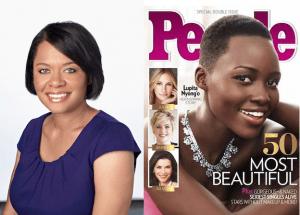People Magazine Accused of Racial Discrimination in Lawsuit
A recent lawsuit against People Magazine aims to force the publication to take a hard look at its track record regarding racial equality both behind the scenes and within the pages of the magazine.
 Tatsha Robertson, a recently dismissed People Magazine Senior Editor and African American woman, has filed suit against the publication; its parent company Time, Inc.; and her former supervisor Betsy Gleick for unlawful discrimination in violation of the Civil Rights Act. Robertson alleges that during her five years at People she was subjected to unequal and racially discriminatory treatment, which culminated in her eventual firing.
Tatsha Robertson, a recently dismissed People Magazine Senior Editor and African American woman, has filed suit against the publication; its parent company Time, Inc.; and her former supervisor Betsy Gleick for unlawful discrimination in violation of the Civil Rights Act. Robertson alleges that during her five years at People she was subjected to unequal and racially discriminatory treatment, which culminated in her eventual firing.
Robertson’s complaint alleges that she experienced an ongoing pattern of unequal treatment by Top Editor Betsy Gleick. The complaint provides several examples: Gleick’s cancelling or simply failing to show up for essential one-on-one meetings prevented Robertson from pitching her stories at staff meetings; Gleick left Robertson off of important emails concerning stories Robertson was working on; Gleick failed to invite Robertson to work lunches that Gleick invited her other direct reports to; and Gleick allowed other editors to publish stories within Robertson’s subject area (crime) but rejected Robertson’s pitches if they even remotely treaded into another editor’s subject area.
However, the most interesting and potentially controversial allegations in the complaint are those relating to the actual content of People Magazine. Robertson’s complaint recounts pitches that Gleick rejected seemingly because the stories involved African American victims. In one instance, Gleick rejected a story that Robertson pitched about an African American model that was murdered, allegedly stating that the victim looked like a “slut” and telling Robertson, “You know the rule – white woman in distress.” In another, Gleick approved Robertson to work on a story about the effects of gun violence on school children, but cancelled the story upon discovering that the majority of examples involved minorities in urban settings rather than “white middle-class suburbia.”
Robertson’s complaint goes even further, discussing the disproportionately low number of African Americans selected for the cover of People, named Sexiest Man Alive, and named Most Beautiful. The complaint also states that many of the African Americans who are chosen for the cover are airbrushed to make their skin appear lighter. Here, Robertson provides two more examples of Gleick’s discriminatory attitudes. In one instance, Gleick did not want to place Queen Latifah on the magazine’s cover because Lupita Nyong’o and Robin Roberts had covered the magazine during the two preceding weeks. In another, Robertson alleges that Gleick was “obsessed” with vetting Trayvon Martin for something sordid in his past before placing him on the cover, despite never making similar efforts to vet white crime victims.
Some commenters have questioned the relevance of information regarding People’s content to Robertson’s employment-based claim. In fact, this information could very well be relevant for purposes of showing a pattern of racial bias. It is clear that Robertson was treated differently from her peers, but Robertson must also prove that her unequal treatment was the result of racial bias. People, Time, and Gleick will likely claim that Robertson’s unequal treatment was due to some other factor, such as work performance or personality issues. The comments made by Gleick – even though they were about potential stories and not about Robertson personally – are relevant to show that Gleick held discriminatory views, which bolsters Robertson’s claim that her treatment was in fact the result of racial bias.
Robertson’s complaint also takes a broad look at People’s organizational structure: People has never had an African American Top Editor; Robertson was the first and only African American Senior Editor in People’s history; only eight out of 110 employees at People were African American; and that number dropped to four after the recent round of layoffs. This data, coupled with Robertson’s assertion of her strong qualifications and work record, further supports the argument that Robertson’s dismissal was the result of racial discrimination.
The nature of the facts and statistics included in Robertson’s complaint has led much of the commentary surrounding this case to devolve into a debate over whether publications, such as People, have a legal or ethical duty to provide racially balanced coverage. However, if this lawsuit goes to trial, the question the court will have to debate is whether the evidence provided suggests a racially discriminatory attitude on the part of People Magazine and its supervisory employees that affects not only the content of the magazine but how the publication treats its employees.


Comments